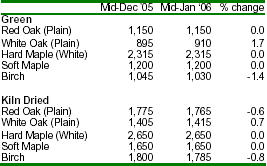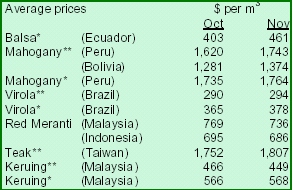The US hardwood market: Northern sub-region
Most hardwood forests in North America are located in the eastern portion of the continent, while coniferous woods are found predominantly along the Pacific coast. The eastern hardwood region is made up of three distinct geographical sub-regions:(1) the North, (2) the Appalachians, and (3) the South. This article focuses on the Northern sub-region. Two subsequent articles will focus on the Appalachian and Southern sub-regions.
From a commercial point of view, cherry, hard maple, red oak and walnut are the most valuable hardwoods. Other indigenous species include ash,aspen, beech, birch, elm, hickory, poplar and willow. Many species are found in all three regions, such as red oak, white oak, soft maple, beech, ash and basswood. However, even trees of the same species but grown in different geographic latitudes do not have the same properties. Their maturation time (and wood-density) as well as their size and diameters differ. The most popular species in the
Northern sub-region are oak (red and white), maple (hard and soft) and birch. These species, plus cherry and walnut, are demanded in the commercially most productive Appalachian region. The South has the greatest diversity of species, but relatively few are of great commercial value, such as cherry, oak (red and white) and soft maple.
Most secondary wood product manufacturing industries in the USA performed satisfactorily in
2005. Helped by low mortgage rates, housing was the driving force for hardwood producers and
end-users throughout the USA. Consumers' appreciation for the look and feel of solid hardwood is on the rise, as evidenced by the increased usage of hardwoods in new houses and remodelling projects. However, housing construction is slowing down. Single -family housing starts have been only at around the 1.7 million units mark (annualized basis) in the second half of 2005, compared to almost 2 million early in the year. The market conditions in the Northern hardwood region are affected by the same economic forces, but there are few peculiarities unique to this region.
Prices of key species in North Eastern USA
($/1000 bf, 1¡±, top quality, FOB mill, truckload quant.)

Green lumber prices on a general upward trend The housing construction slowdown is more
pronounced in the North Eastern USA than elsewhere in the country and therefore the demand
for kiln-dried lumber in this region is waning. The situation is accentuated by the ample supply of kiln-dried lumber. During early 2005, the demand for green hardwood lumber was very slow and many northern suppliers chose to kiln-dry and stock-pile the wood that could not be sold. This led to a complete reversal of the market conditions later in the year and the current excess of kiln-dried lumber. On the other hand, log decks are now relatively sparse and green lumber in the Northern region and Canada is much less abundant. Green
lumber prices are on a general upward trend while prices for kiln-dried lumber are flat.
Red oak demand subdued
End-user¡¯s interest for red oak remains subdued. Most buyers order only limited amounts for
replacement purposes. The sole stabilizing force is the long-established customer-supplier relationships that account for a large portion of the business volume. Ample availability coupled with limited demand has led to an ongoing price decline. The price erosion is most obvious for kiln-dried red oak lumber as explained above. Prices for the lower quality grades fell much more than for the upper grades. On the other hand, low log decks across
much of the Northern USA and Canada are limiting sawmills¡¯ output of green lumber. As a result,supplies of green red oak are more closely aligned with demand and prices are under less pressure.
Strong demand for white oak
Demand for the upper grades of kiln-dried white oak continues to be strong. Interest stems from both domestic and offshore markets. The solid demand for kiln-died lumber has also fuelled increased sales for green wood as wholesalers and exporters attempt to replenish their depleted inventories. Prices of kiln-dried lumber surged about $10 during the last 30 days. Green lumber prices went up to an even larger extent.
Maple market stable
Late last year, some shortage of maple logs could be observed in the Northern Region. Nevertheless, lumber production was sufficient to keep demand and supply in balance and prices of this important species remained stable. Since the beginning of this year, however, it seems that lumber buyers are taking a more cautious approach to purchases, limiting orders to "as-needed" quantities. It may be that maple prices will soften slightly in the near future.
Demand for yellow birch weakens
Demand for US yellow birch is weakening and prices are declining. Sawmills have lost market
share to foreign supplies, in particular Baltic birch. Also, alternative species are gaining ground from yellow birch. For instance, shifting consumer preferences for hard maple have a detrimental impact on birch. Nevertheless, specialty products, such as ¡°coloured birch¡± and lumber sorted for sap content, continue to sell well.
Review of duties on Chinese bedroom furniture
On 4 January 2006, the US Department of Commerce (DoC) began an administrative review
of import duties imposed on Chinese-made wood bedroom furniture in 2004. In mid-2004, the USA had imposed anti-dumping duties ranging from 2.32% to 198% on Chinese bedroom furniture,
depending on the degree of alleged "unfair pricing". Companies which cooperated in the investigation were subjected to a rate of 6.65%, known as Section "A" rate.
As part of the current process, the DoC will accept requests by Chinese furniture exporters to review the duties assigned to them. The process gives manufactures a chance to have their duties lowered, but it also could result in higher duties. In addition to changing rates for individual companies, the administrative review could also affect the Section "A" rate. Chinese companies seeking a review have one month to file a claim with the DoC and the
review is expected to be completed within one year.
Housing starts slow as builders grow cautious
US new residential construction finished last year on the decline, as slowing sales, rising inventories and higher costs made builders grow more cautious. The DoC said that December housing starts fell 8.9% from November to an annually seasonally adjusted 1,933,000 units. However, an estimated 2,065,000 housing units were started in 2005, on an unadjusted basis, 5.6% more than in 2004 and the second highest level on record after 1972's 2,357,000.
New Jersey plans ban on tropical wood
The international Wood Products Association (IWPA) announced recently that legislation has
been introduced again in New Jersey, USA that would ban State governments from using public
funds to build or renovate boardwalks using tropical wood unless it is FSC-certified. Hearings have not yet been scheduled. IWPA informed that it will be work to defeat the legislation.
US Imported Sawnwood Prices

*Dimension lumber; **Rough lumber
|